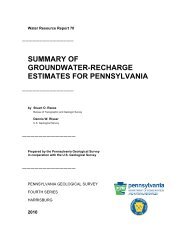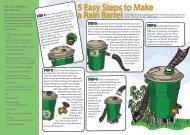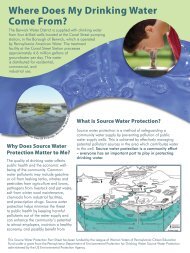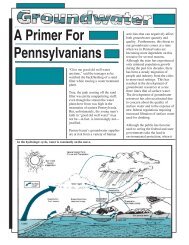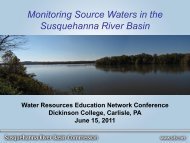NITROGEN POLLUTION: - Hubbard Brook Research Foundation
NITROGEN POLLUTION: - Hubbard Brook Research Foundation
NITROGEN POLLUTION: - Hubbard Brook Research Foundation
You also want an ePaper? Increase the reach of your titles
YUMPU automatically turns print PDFs into web optimized ePapers that Google loves.
The consumption of protein, and the associated consumption of nitrogen, has<br />
been tracked by the U.S. Department of Agriculture since 1909 (grams of nitrogen =<br />
grams of protein/6.25). With the increase in population and per capita consumption<br />
of nitrogen, the total amount of nitrogen consumed in New England and New York<br />
has risen steadily since the early 1900s (see Figure 5). The average human body<br />
needs roughly 2.0 grams of nitrogen per day to support basic metabolic functions<br />
(Galloway and Cowling 2002). The typical American diet supplies approximately<br />
13 grams of nitrogen per day (Boyer et al. 2002).<br />
Food generates reactive nitrogen in the environment as a byproduct of both<br />
food production and<br />
food consumption.<br />
Food production<br />
leaves a legacy of<br />
reactive nitrogen in<br />
the regions where<br />
it is produced. It is<br />
estimated that 10<br />
times the amount<br />
of nitrogen is used<br />
during the food<br />
production process<br />
than is ultimately<br />
consumed by humans<br />
as protein (Galloway<br />
and Cowling 2002).<br />
Much of this additional<br />
nitrogen is<br />
applied as fertilizer<br />
that can run off into<br />
groundwater, rivers<br />
and coastal waters.<br />
Moreover, the production<br />
of animal protein<br />
adds substantial<br />
quantities of reactive<br />
nitrogen to the<br />
environment in the<br />
form of nitrogen-rich<br />
manure that can<br />
decrease water quality<br />
in agricultural areas.<br />
Once food is<br />
consumed, it can<br />
contribute to pollution<br />
through the production<br />
and discharge of<br />
sewage. Humans do<br />
not utilize all of the<br />
Nitrogen in the Food Cycle<br />
Meat: 7.7 grams N<br />
Peas: 0.7 grams N<br />
1. Food imported<br />
4. Nitrogen discharged by<br />
treatment plants<br />
Note: the nitrogen content in food groups is based on a single serving.<br />
Source: http://www.nal.usda.gov/fnic/cgi-bin/nut_search.pl<br />
Milk: 1.3 grams N<br />
Bread: 0.4 grams N<br />
nitrogen contained in food. The remaining nitrogen is lost as waste to septic systems<br />
or wastewater treatment plants. While the technology exists to remove reactive<br />
nitrogen from wastewater, investments in these upgrades have not been made at<br />
most treatment plants (see Box on page 21). Since most septic systems and treatment<br />
plants do not effectively remove nitrogen from the waste, reactive nitrogen is<br />
eventually discharged to rivers and coastal waters where it contributes to water<br />
quality problems (see Figure 6).<br />
2. Food consumed<br />
3.Nitrogen wasted<br />
k<br />
FIGURE 6:<br />
Nitrogen in food is a<br />
major contributor to<br />
nitrogen loading in<br />
Northeast estuaries.<br />
PAGE 8



